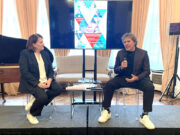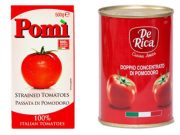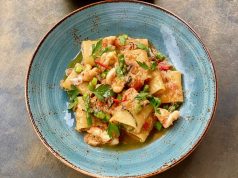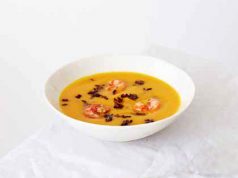Orecchiette, or ‘little ears’, are such a typical Puglian thing, a very ergonomically shaped pasta that was being made by hand long before the invention of machines to pass the pasta through dyes, or moulds, to shape them and then dry them. When orecchiette are made by hand, the pasta dough is rolled out into thin cylinders, which are cut into little pieces and then pressed and curled into an ear shape in one deft movement. Because the strands of protein are aligned first one way, in the rolling, and then in the opposite way in the pressing and stretching, this builds a great strength into the pasta, so that it is capable of holding any sauce, especially an oily, tomato-ey one. I like to imagine that this ancient instinctive technology in the home kitchen was how we learned to build and strengthen materials for later industries, like car manufacturing – Italians always claim that everything began with pasta!
When we are on holiday in Puglia we buy our orecchiette fresh from the pastificio, where they are made with quite a rough texture so that they really cling well to whatever sauce you make, but the place that is most famous for hand-made orecchiette is Bari Vecchia, the old medieval part of Bari, which has its own community, completely different to that of the newer part of the town around the port. In certain courtyards bounded by tall houses with balconies, the women, often with their mothers, grandmothers and small children, set up tables outside their doors each morning with their homemade pasta dough, ready to make the orecchiette. There is a whole social life built around the cutting and shaping, as these women sit and chat with their neighbours, sometimes singing, and their dexterity is incredible. They work so fast, not even looking at what they are doing, and within minutes their tables are full of the little ears. At about 12 o’clock the townspeople arrive on their scooters, bicycles, in their cars or on foot to buy the orecchiette, take them home, maybe to their mothers, to cook them for lunch, and then they go back to work or their daily life.
Orecchiette are brilliant with sauces made with olive oil and vegetables, such as cime di rapa (turnip tops) with chilli and garlic, anchovies too, if you like. If you are using dried orecchiette, look for ones that have been shaped using a traditional bronze die. This gives them a slightly rough edge so that they hold on to the sauce better than a more shiny pasta cast withm a teflon die.
I also love orecchiette with tomato sauce and salted ricotta. Ricotta (which means re-cooked) is a very southern Italian thing, made using the ancient idea of bring- ing the whey left over from cheese-making up to a high temperature in a pot, then skimming off the creamy sweet-tasting proteins that rise to the surface and drain- ing them in rush baskets. The story goes that it was first made accidentally by a shepherd who left a pot of whey on the fire after cooking up a rudimentary cheese in a field with his flock.
Once drained, the fresh ricotta (fresca) is sold in tubs, but because it is quite deli- cate and cannot be kept, some of it is also salted, pressed and matured, so that it becomes semi-hard and can be sold by the piece, for grating over pasta or salads. You can keep this ricotta salata (salted ricotta) in the fridge for years, and it will never go off, because it has been both cooked, and salted and matured. Even if it grows a little mould, just scrape this off and the
cheese will still be good.
I love salted ricotta, but it is a bit of an underdog in the cheese world, outshone
by Parmesan and grana padano. It has a different, almost fluffier, consistency than those cheeses that makes it exceptionally elegant and velvety in the mouth. It is typically grated over pasta Norma, the Sicilian dish made with aubergines, and I like it grated over a spinach salad, or in a sandwich with honey: that combination of sweet and salty is delicious.
Serves 6
olive oil 2 tablespoons
onion 1 small, chopped
garlic 1 clove, finely chopped
ripe cherry tomatoes 500g, quartered sea salt and freshly ground black pepper fresh or dried orecchiette 500g salted ricotta 200g, grated
fresh basil 5 leaves
extra virgin olive oil 2 tablespoons
1 Heat half the olive oil in a sauté pan, add the onion and garlic and cook gently until the onion is soft and translucent, taking care not to burn the garlic. 2 Put in the tomatoes, cover with a lid, simmer for 5 minutes, checking and adding a little water if the mixture dries out, then season to taste. 3 Cook the orecchiette in a pan of boiling salted water for about 8–10 minutes (or according to the packet instructions) until just al dente, then drain, reserving a little of the cooking water. 4 Toss the orecchiette in the tomato sauce, with half a ladleful of the cooking water and about a quarter of the ricotta, let it rest for a minute, so that the pasta can really suck in the sauce, then toss it again. 5 Add the basil, drizzle with the extra virgin olive oil, and
sabato, Luglio 5, 2025
Welcome! Log into your account
Recover your password
SM La Notizia Londra da oltre 12 anni il punto di rifermento degli Italiani a Londra
SMPhotoNews - La Notizia Londra riceve i contributi previsti dalla legge per la stampa italiana all'estero
SMPhotoNews - La Notizia Londra riceve i contributi previsti dalla legge per la stampa italiana all'estero
Contact us: smlanotizialondra@gmail.com
© Copyright 2016 - Director Salvatore Mancuso
Credits: DOG ADV - Digital Marketing Agency in London
Credits: DOG ADV - Digital Marketing Agency in London























